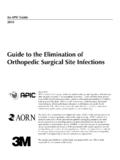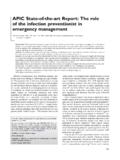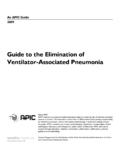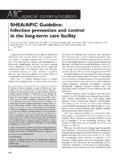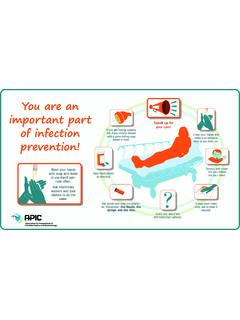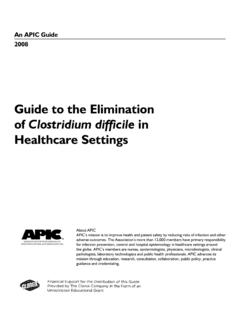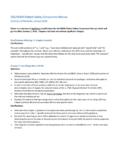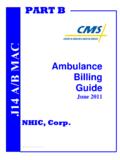Transcription of Guide to the Elimination of Infections in Hemodialysis
1 An apic Guide 2010. Guide to the Elimination of Infections in Hemodialysis About apic . apic 's mission is to improve health and patient safety by reducing risks of infection and other adverse outcomes. The Association's more than 12,000 members have primary responsibility for infection prevention, control, and hospital epidemiology in healthcare settings around the globe. apic 's members are nurses, epidemiologists, physicians, microbiologists, clinical pathologists, laboratory technologists, and public health professionals. apic advances its mission through education, research, consultation, collaboration, public policy, practice guidance, and credentialing. Financial Support for the Distribution of This Guide Provided by Professional Disposables International, Inc. in the Form of an Unrestricted Educational Grant For additional resources, please visit Look for other topics in apic 's Elimination Guide Series, including: Catheter-Associated Urinary Tract Infections Clostridium difficile CRBSIs Mediastinitis MRSA in Hospital Settings MRSA in Long-Term Care Ventilator-Associated Pneumonia Copyright 2010 by apic .
2 All rights reserved. No Part of this publication may be reproduced, stored in a retrieval system, or transmitted, in any form or by any means, electronic, mechanical, photocopying, recording, or otherwise, without prior written permission of the publisher. All inquires about this document or other apic products and services may be addressed to: apic Headquarters 1275 K Street, NW. Suite 1000. Washington, DC 20005. Phone: Email: Web: Disclaimer apic provides information and services as a benefit to both apic members and the general public. The material presented in this Guide has been prepared in accordance with generally recognized infection prevention principles and practices and is for general information only. The Guide and the information and materials contained therein are provided AS IS , and apic . makes no representation or warranty of any kind, whether express or implied, including but not limited to, warranties of merchantability, noninfringement, or fitness, or concerning the accuracy, completeness, suitability, or utility of any information, apparatus, product, or process discussed in this resource, and assumes no liability therefore.
3 ISBN: 1-933013-46-X. Guide to the Elimination of Infections in Hemodialysis Table of Contents Acknowledgments .. 6. Acronyms .. 9. Guide Overview .. 11. Purpose .. 11. Introduction .. 11. HD Infection Prevention and Control Program .. 11. Emergency Preparedness .. 12. References .. 12. Problem Identification.. 13. Conclusion .. 14. References .. 14. Further Readings .. 14. Infection Prevention and Control in HD .. 16. Introduction .. 16. References .. 19. Further Readings .. 19. Environmental Cleaning/Disinfection .. 20. Background .. 20. Cleaning and Disinfection of Environmental Surfaces .. 20. MDRO Cleaning and Disinfection.. 21. References .. 22. Further Readings .. 22. Equipment Cleaning/Disinfection .. 23. Background .. 23. Exterior Cleaning and Disinfection of Dialysis Machine .. 26. Interior Disinfection of Dialysis Machine.
4 26. Monitoring Dialysis Machine Disinfection .. 26. Auxiliary Equipment .. 27. Reprocessing and Reuse of Hemodialyzer .. 28. References .. 28. Further Readings .. 28. Hand Hygiene .. 29. References .. 30. Further Readings .. 30. Patient Immunizations and TB Screening .. 31. Additional Detail: HBV Vaccination .. 31. TB Screening.. 32. References .. 32. Further Readings .. 33. Medication Safety and Injection Practices .. 34. Background .. 34. General Principles .. 34. ASSOCIATION FOR PROFESSIONALS IN INFECTION CONTROL AND EPIDEMIOLOGY 3. Guide to the Elimination of Infections in Hemodialysis Aseptic Technique.. 34. IV Solutions .. 34. Flushing .. 34. Syringes .. 35. Vials .. 35. References .. 35. Further Readings .. 35. Patient and Employee Education .. 37. References .. 37. Presurgical (HD Access) Infection Prevention.
5 38. Preoperative Showers/Bathing .. 38. Hair Removal .. 38. Vascular Access Protection .. 38. Active Surveillance Screening for MRSA and Decolonization .. 38. Postsurgical Care .. 39. Postsurgical Care of an HD Access (Temporary or Permanent) .. 39. References .. 40. Standard Precautions .. 41. PPE Guidelines for Standard Precautions in HD Settings .. 41. HBV Isolation/Precautions .. 43. Introduction .. 43. HBV Isolation/Precautions .. 43. Risk Factors for HBV Infection in HD Units .. 44. HIV Positive Patients .. 44. HCV Positive Patients.. 44. References .. 45. Further Readings .. 45. Respiratory Hygiene/Cough Etiquette .. 46. References .. 46. Transmission-Based Precautions .. 47. When Additional Precautions are Recommended for MDRO in HD Faciliti .. 48. References .. 49. Vascular Access Infection Prevention During Insertion and Care.
6 50. Overview .. 50. Types of Vascular Access .. 50. Temporary Access: Indwelling Catheters (Cuffed or Uncuffed) and Port Catheters .. 50. Catheter Insertion .. 50. Catheter Care .. 51. Skin Antiseptics for Exit-Site Care .. 51. Exit-Site Dressings and Ointment .. 52. Permanent Access: Fistulas/Grafts .. 54. Overview .. 54. Permanent Access (AVF or AVG) .. 54. Cannulation of AVFs .. 54. Cannulation of AVGs .. 55. 4 ASSOCIATION FOR PROFESSIONALS IN INFECTION CONTROL AND EPIDEMIOLOGY. Guide to the Elimination of Infections in Hemodialysis References .. 55. Further Readings .. 56. Water Treatment and Testing.. 58. Bacteriology of Water and Dialysate .. 58. When Bacteria and Endotoxin Levels are Exceeded .. 58. Bacteriologic Monitoring of Water and Dialysate.. 59. References .. 59. Further Readings .. 59. Surveillance Methodology for Dialysis Infections .
7 61. Background .. 61. Monitoring the Dialysis Population .. 61. Surveillance Tools .. 62. Analysis and Reporting .. 63. References .. 65. Further Readings .. 65. Employee Health Considerations .. 66. References .. 66. Unresolved Infection Prevention Issues and Measures .. 67. Active S. aureus/MRSA Surveillance Testing/Decolonization .. 67. Antibiotic Locks .. 67. Environmental Cleaning/Disinfection .. 68. HD Reliable Outflow (HeRO) VAD (Graft/Catheter) .. 69. PPE .. 69. Postoperative Antiseptic Dressing .. 69. Skin Antisepsis .. 70. Sodium Hypochlorite .. 70. Medihoney for Exit Site Care .. 70. Ultrapure Dialysate .. 70. References .. 71. Further Readings .. 72. Conclusion Putting it All Together .. 75. Appendices .. 76. General Appendices .. 76. Patient Teaching Tools .. 77. Nephrology Resources .. 77. General Information.
8 77. ASSOCIATION FOR PROFESSIONALS IN INFECTION CONTROL AND EPIDEMIOLOGY 5. Guide to the Elimination of Infections in Hemodialysis Acknowledgments The Association for Professionals in Infection Control and Epidemiology ( apic ) acknowledges the valuable contributions of the following individuals: Lead Author Sue Barnes, RN, BSN, CIC. Kaiser Permanente, Oakland, CA. Authors Danilo Concepcion, CCHT, CHT. St. Joseph Hospital, Orange, CA. Gwenda Felizardo, RN, BSN. CIC Group Health Cooperative, Tacoma, WA. John Moran, MB, BS. Satellite Healthcare, Mountain View, CA. Vickie Peters, RN, MSN, MA, CPHQ. SCal Kaiser Permanente Renal Services, Pasadena, CA. Stan Shapiro, MD. Kaiser Permanente, Panorama City, CA. Marlon Yu, RN, BSN. SCal Kaiser Permanente Renal Services, Pasadena, CA. 6 ASSOCIATION FOR PROFESSIONALS IN INFECTION CONTROL AND EPIDEMIOLOGY.
9 Guide to the Elimination of Infections in Hemodialysis Reviewers Priti Patel, MD, MPH. Division of Healthcare Quality Promotion Centers for Disease Control and Prevention, Atlanta, GA. Disclaimer: The findings and conclusions in this report are those of the authors and do not necessarily represent the official position of the Centers for Disease Control and Prevention. Sylvia Garcia-Houchins University of Chicago Medical Center, Chicago, IL. Tanya Nicholls, RN, BN, CIC. Southern Cross Hospitals Ltd, New Zealand Allen Nissenson, MD. Davita, El Segundo, CA. David Pegues, MD. Davita, El Segundo, CA. ASSOCIATION FOR PROFESSIONALS IN INFECTION CONTROL AND EPIDEMIOLOGY 7. Guide to the Elimination of Infections in Hemodialysis Conflict of Interest Sue Barnes, RN, BSN, CIC has nothing to disclose Danilo Concepcion , CCHT, CHT has nothing to disclose Gwenda Felizardo, RN, BSN, CIC has nothing to disclose John Moran, MB, BS has nothing to disclose Vickie Peters, RN, MSN, MA, CPHQ has nothing to disclose Stan Shapiro, MD has nothing to disclose Marlon Yu, RN, BSN has nothing to disclose 8 ASSOCIATION FOR PROFESSIONALS IN INFECTION CONTROL AND EPIDEMIOLOGY.
10 Guide to the Elimination of Infections in Hemodialysis Acronyms AAMI Association for the Advancement of Medical Instrumentation apic Association for Professionals in Infection Control AV arteriovenous AVF arteriovenous fistula AVG arteriovenous graft BSI bloodstream infection CDC Centers for Disease Control and Prevention CFU colony forming units CHG chlorhexidine CKD chronic kidney disease CMS Centers for Medicare and Medicaid Services CVC central venous catheter EPA Environmental Protection Agency ESRD end stage renal disease EU endotoxin unit FDA Food and Drug Administration HBV hepatitis B virus HCV hepatitis C virus HD Hemodialysis HICPAC Healthcare Infection Control Practices Advisory Committee HIV human immunodeficiency virus IP infection preventionist IV intravenous KDOQI Kidney Disease Outcome Quality Initiative MDRO multidrug-resistant organism mL milliliter MMWR Morbidity and Mortality Weekly Report MRSA methicillin-resistant Staphylococcus aureus MWCO molecular weight cut off NHANES National Health and Nutrition Examination Survey PPE personal protective equipment ppm parts per million QAPI quality assurance and performance improvement RO reverse osmosis ASSOCIATION FOR PROFESSIONALS IN INFECTION CONTROL AND EPIDEMIOLOGY 9.


